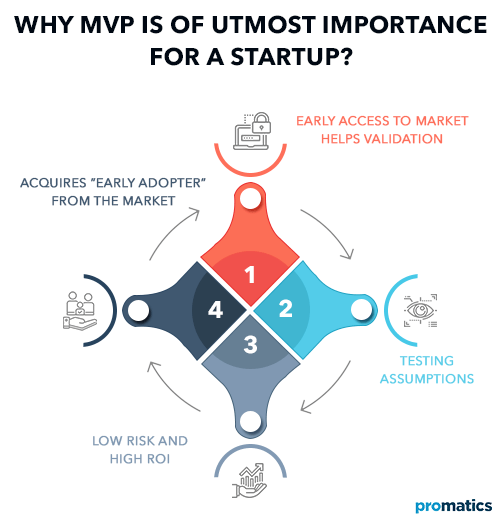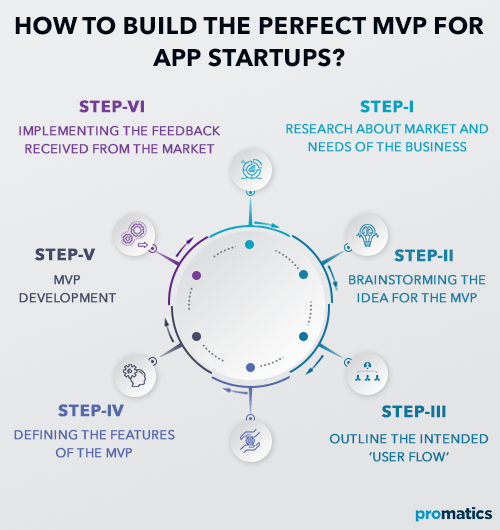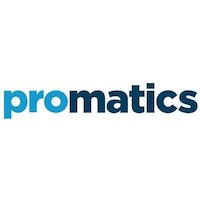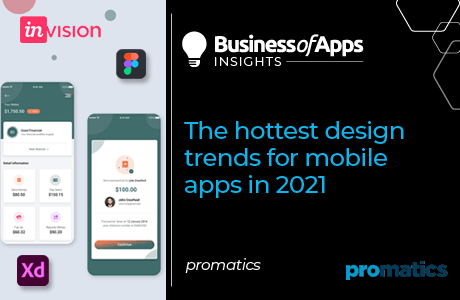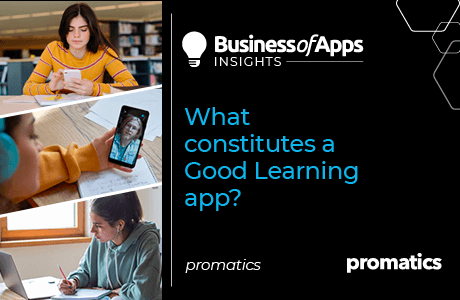What is an MVP Exactly?
Businesses must focus on releasing a product following the ‘build-measure-learn ‘feedback loop. They should begin with the initial step of finding out the real-world problem they can solve by learning present scenarios. They must then use their ideas to build a Minimum Viable Product, which imitates the ultimate functionality of the product.
MVP is essentially a way to start a project quickly and realize what is next in the process. Thus, the startup should always begin with an MVP for a product. Startups can build practical solutions in the form of MVPs to test the feasibility of the main flows of product ideas. Once made, MVP can help businesses measure and learn about the concept, its usefulness, financial implications, and market acceptance.
Significance of MVP for a Startup
Because an MVP is the first shippable product that is delivered to us, it effectively gauges how the product is going to be received. Developing an MVP also helps validate the existence of demand for a product. Further, an MVP helps create interest for a particular product even before the full version of that product is ready to be launched.
Let’s begin with first discussing the significance of an MVP for a startup:
- Early Access to Market Helps Validation
Most startups envision that the market will embrace the new product or service they are going to launch due to its ability to solve an urgent problem faced by the market. They often opt to create a full product based on their initial vision and then make it available to the target market. However, sometimes the product doesn’t get as much traction from the market concerned. It may be because of the wrong choice of exchange or because the product was not compelling enough. Thus app businesses deal with a high degree of risk when developing a full product and then testing it in the market.
Building an MVP helps businesses validate their products, services, or ideas at a fast pace. It further allows firms to decide whether to continue pursuing their product idea any further. A business can also choose to modify their app product to suit the needs of an end customer better on benefitting from early access to the market.
Startups should operate in such a way that they have a chance to learn while they ensure that their vision is viable. MVPs can effectively replace ambiguity with certainty for startup app businesses. Startups must always experiment and test different versions of its MVP against various metrics to reach possible changes that can increase the level of viability of the app.
- Testing Assumptions
Very often, app startups are built with the assumption that the product or service they offer provides value to the end customer. They also hold the growth hypothesis seriously. Testing the product or service in the form of an MVP app, startups find themselves better equipped to solve the problems of the target audience.
Since startups benefit from validating their growth and value hypotheses early on in the product development lifecycle, they consider developing a version of the product that is at a level of completion. This product often showcases the standard of value that it can bring to customers in the target market.
Thus, MVPs with capabilities necessary to measure the traction in the market are a success. They effectively test the assumptions of the business. All startups can benefit from learning the results from testing versions of MVPs they launch.
Your playbook for the new app ecosystem [webinar]
The app stores have been cracked open. Savvy teams are already capitalizing by implementing App2Web and Web2App strategies. Join Paddle’s Lucas Lovell to discover smarter billing tactics.
Register now
- Low Risk and High ROI
MVPs are low-risk products, but they hold the promise of exponential results. Because they contain just the bare minimum core features of a product, they not only require less time to develop but also cost a fraction of the actual product. Startups can save time and money during product development and marketing and reinvest it into customer development. This ensures a better app product and increases their chances of success. Startups must release an MVP and only add features that users specifically request.
- Acquires “Early Adopter” From the Market
It’s essential to target the right set of audience for the success of an MVP. The ‘early adopters’ or influencers need to be targeted with the MVP as they are the most passionate about the product. Startups can access feedback and promote to others within the niche when they begin with these early adopters.
Different Approaches to Build an MVP for Startups
The definition of a viable minimum viable product is often quite broad. It comprises various types of approaches. An app by virtue of being an MVP isn’t supposed to be a final finished product. Instead, MVPs are products that will achieve its goal by subtraction. Here are different kinds of MVP products discussed below:
- No Product MVP
A no-product MVP is the code method where businesses validate an idea and receive feedback without any actual coding. Here companies count on marketing campaigns to test the opportunity in theory. The scheme only represents or explains everything in the diagram form. They use landing pages, campaigns for advertising, surveys, video explainers, blogs, etc. to push the concept to the market. It is an excellent way to kickstart a product pre-sale or raise an investment before it is built.
- Product Mock-Up MVP
Building a mock-up MVP helps businesses showcase some of the features of a future product. Developers often replace certain sophisticated automated features with easier-to-create or manually controlled solutions. MVP concierge lacks sophisticated technology and leverages Amazon Mechanical Turks to execute its functions. Wizard Of Oz also uses manual labor to replicate core functionality. However, they offer a close-to-genuine user experience.
- MLP
With a focus on customer satisfaction and the minimum viability of a product, MLP is an abbreviation used for the minimum lovable product. The aim is to create such a product that creates a strong first impression and renders a memorable experience.
Guide to Build an MVP for App Startups
- Step I – Research About Market and Needs of the Business
Analysis of the basic premise is essential before a startup begins work on an MVP. Look at what the product does — state what problem does it solve? While this may seem like a very textbook thing to do, it will help businesses make an informed decision. Initial research also includes identifying the target set of audience and studying their motivation for choosing the product on offer. The research phase can also branch out into checking out the competition to decide how to distinguish the product from others in the market. This kind of research helps businesses understand what all qualities the product needs to feature.
- Step II – Brainstorming the Idea for the MVP
All successful products solve some particular problem, so be it with apps. An app that doesn’t solve a problem or doesn’t solve it well enough is doomed to fail. Thus, startups must spend time thinking about USPs that will make their MVP an instant hit. Further, plan an easily scalable MVP.
It’s also essential for startups to brainstorm the manufacturing cost for the initial phase and for the time when it scales. The price also depends on the type of product that the startup is going to launch.
- Step III – Outline the Intended ‘User Flow’
The term ‘user flow’ essentially defines the route that a prospective customer will take with the business. With the goal of designing and developing an app in the most user-friendly way possible, startups must stick to building an application that is as convenient to use as possible. The user flow must feature critical functions that are necessary for a user’s satisfaction.
No matter how simple it sounds, always break down steps to outline how the customers will reach the intended goal of the app. It is essential to identify even the distinct levels so that it narrows down to an end app product that delivers an impeccable user experience. Look into the app from the user’s perspective to ensure that you can simplify the processes. Outlining granular user flows also helps businesses identify areas for improvement further down the line.
- Step IV – Defining the Features of the MVP
Outlining the user flow should help businesses define all the essential features they should include in their MVP, and which ones they should drop. It’s important to draw clear distinctions between what users want and what they need to identify and prioritize critical features. Sticking to user-demand features can destroy the user experience and can compromise the product’s overall purpose. Startups should pick features that are in harmony with the overall goal of their product idea.
After identifying the essential features of the app, prioritize them effectively. Let the critical element of the app be the one that is of most use or interest to the market. Here, you can allocate each aspect to the stages of your user flow to ease the process further.
- Step V – MVP Development
Narrowing down the key features and fully understanding all the consumer & market needs, it’s time to begin the actual MVP development. Any mobile app development company must ensure to build apps so that it is convenient for customers to use. Prepare to build an engaging and suitable app product.
Startups should begin by selecting the technology that best suits the needs of their project. Thoughtful development ensures that the end-product is easily scalable.
- Step VI – Implementing the Feedback Received from the Market
When the MVP is ready, startups can launch it into the market. Simultaneously, the product testing continues to ensure its stability and sustainability. The testing continues post the app development stages. The inclusive testing effort includes checks by quality assurance engineers who improve the product quality, both during the development phase and after the release of the product. The testing effort should also include user acceptance testing to gain end-users feedback about what is missing in the MVP. It not only makes the product better but also reduces the odds of it being a failure in the market. Constant improvement ensures that the startup reaches a final app product that is desirable for the target market and is ready to be monetized for profitability.
Conclusion
Building an MVP simply means that a startup creates the most basic version of their idea in the simplest way possible. They should test their assumptions and optimize their ideas.
We at Promatics believe that most sustainable businesses feature the most straightforward processes. Our team always begins with the essential features and answers the pain points to reach a feature-rich MVP. We also ensure that we validate our ideas in the target market before we pledge any money into it. We help startups gain traction for their idea without asking them to spend thousands of dollars on it, through our prolific MVP apps.





